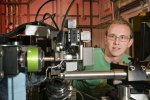Light reactions
What does it look like?

Images generated with OLEX2 software (http://www.olexsys.org/). Nickel is purple, oxygen is red, nitrogen is blue, chlorine is light green, carbon is silver and hydrogens are white.
What is it?
Reactions in a crystal? Yes, there are many crystals that when the external environment is changed (heat, light, pressure, gas, electric field, etc.) the atoms within a crystal can undergo a transformation. Crystallography can be used to monitor these changes giving three-dimensional pictures of the reaction progress – like a molecular movie!!
One particular system is a distorted square planer complex containing a nickel metal centre bound to an ambidentate nitro (NO2) ligand, a bidentate phosphorus ligand called bis(diphenylphosphino)ethane (dppe) and a chlorine atom. The nitro NO2 ligand can bind to the nickel centre through different atoms. Under ambient conditions the nitro binds to the metal centre through the nitrogen atom. When the crystals are exposed to 400 nm light they undergo a single-crystal to single-crystal transformation in which the nitro ligand changes from a η1-N bound to η1-O bound ligand. At low temperatures the η1-O bound species last for prolonged periods of time (known as a metastable state). At higher temperatures it converts back to the η1-N bound ground state. This procedure can be repeated many times without crystal degradation.
Where did the structure come from?
This particular crystal structure was designed by a group from the University of Bath who were particularly interested in following these 'molecular movies' within crystals. These types of crystals have applications in digital storage devices, where each orientation can be used in binary code as a 'switch' in an on or off position (i.e. N- and O- bound conformations).
You can read more about this structure here doi:10.1002/anie.200901706






